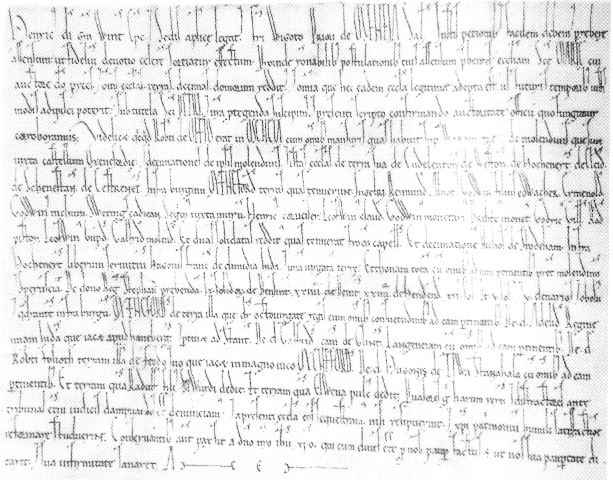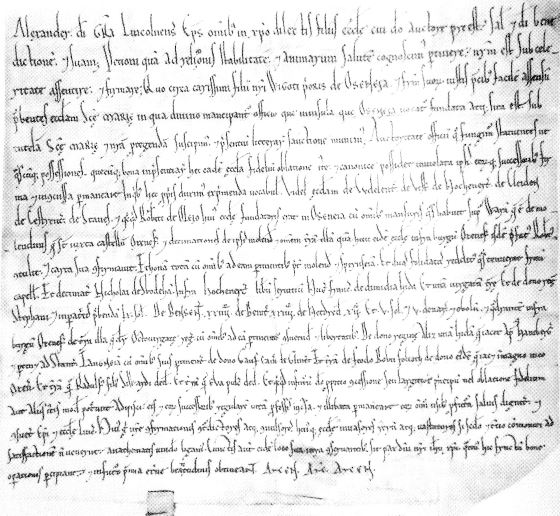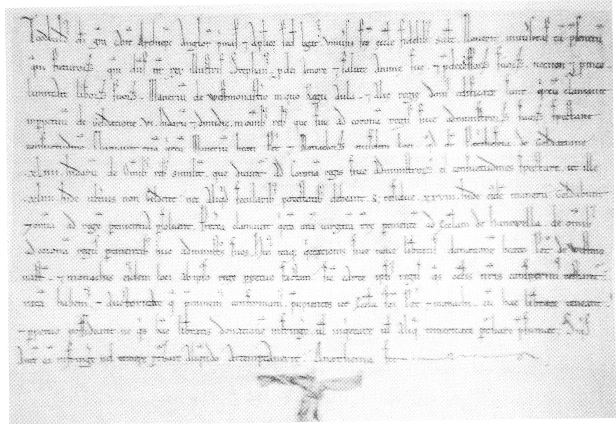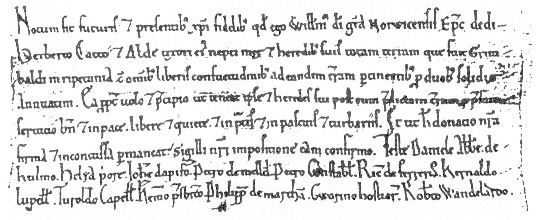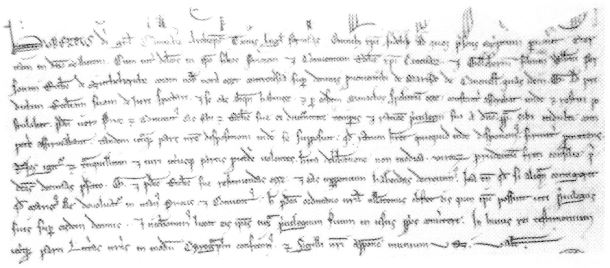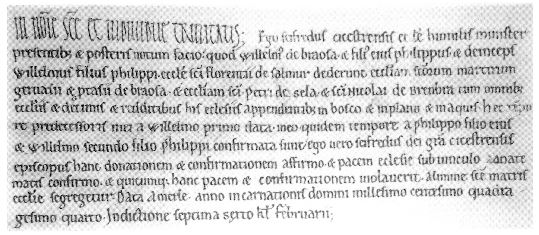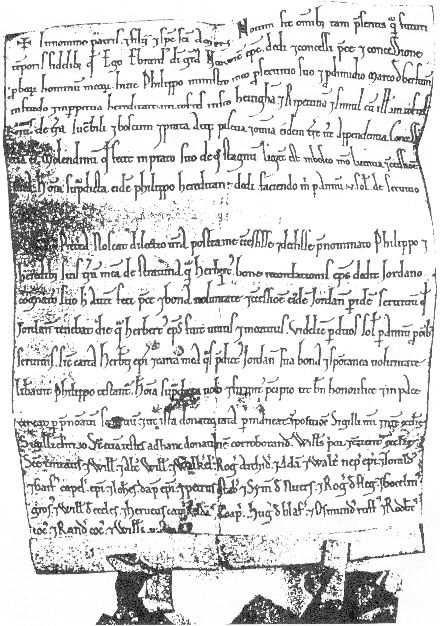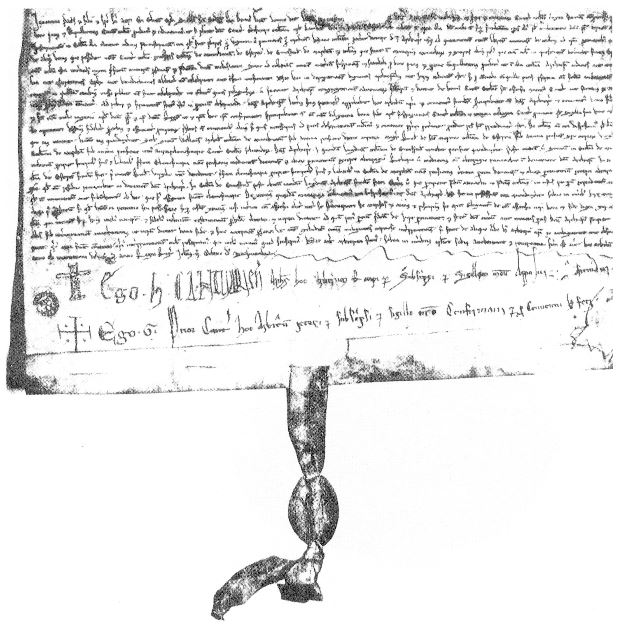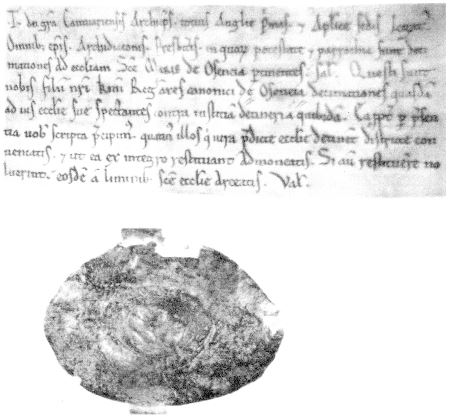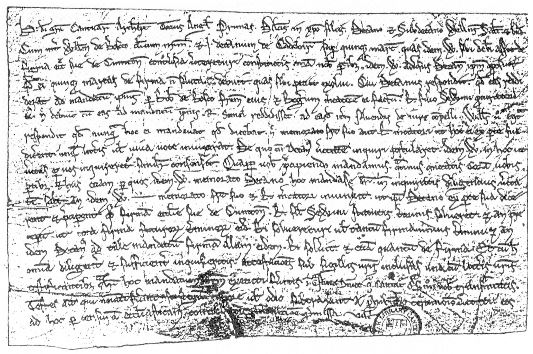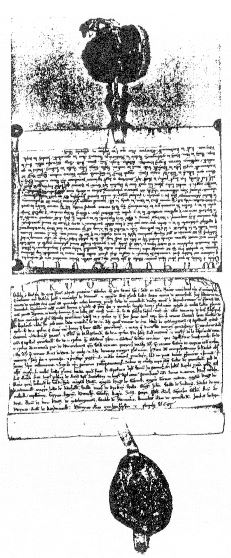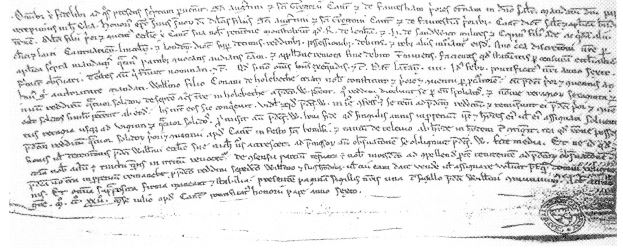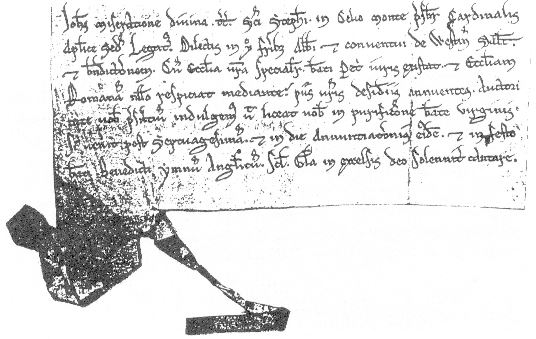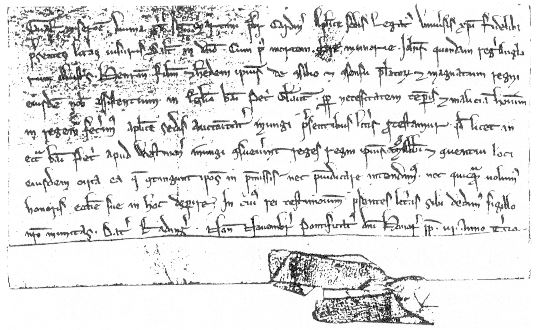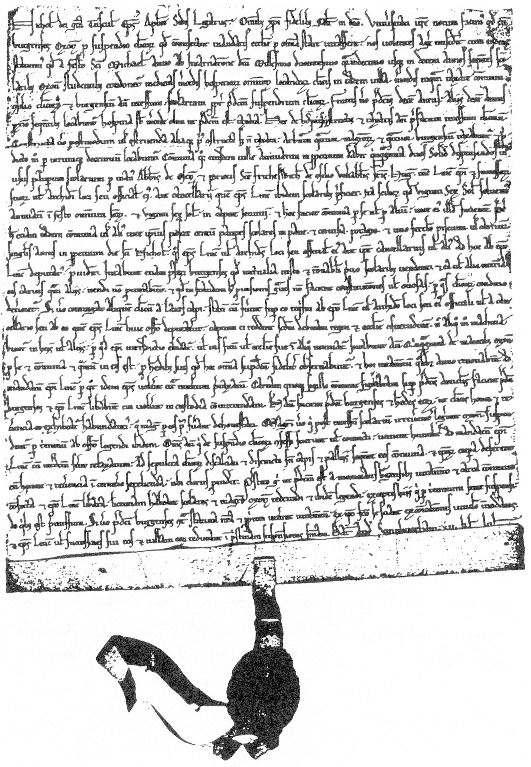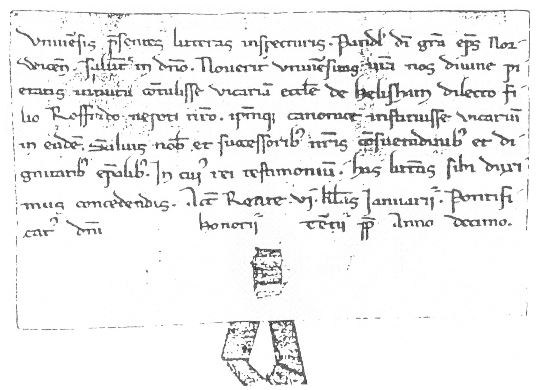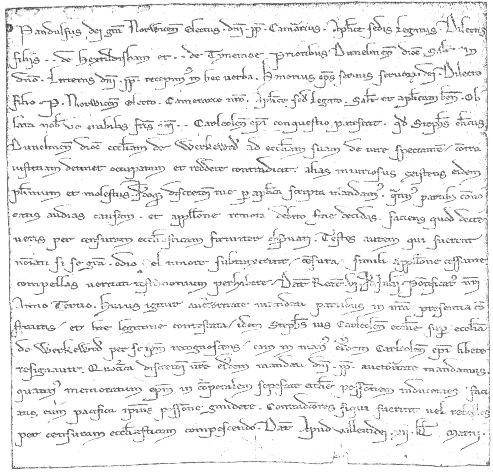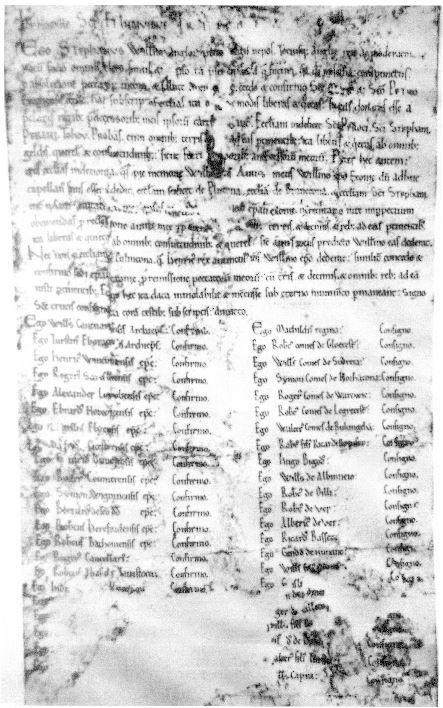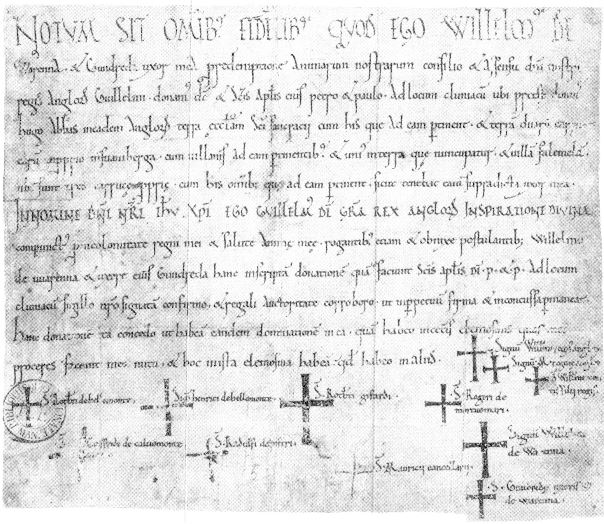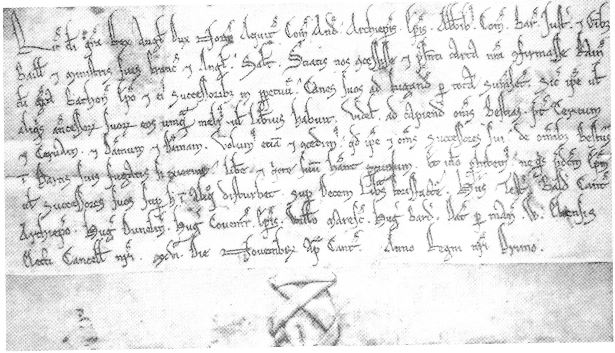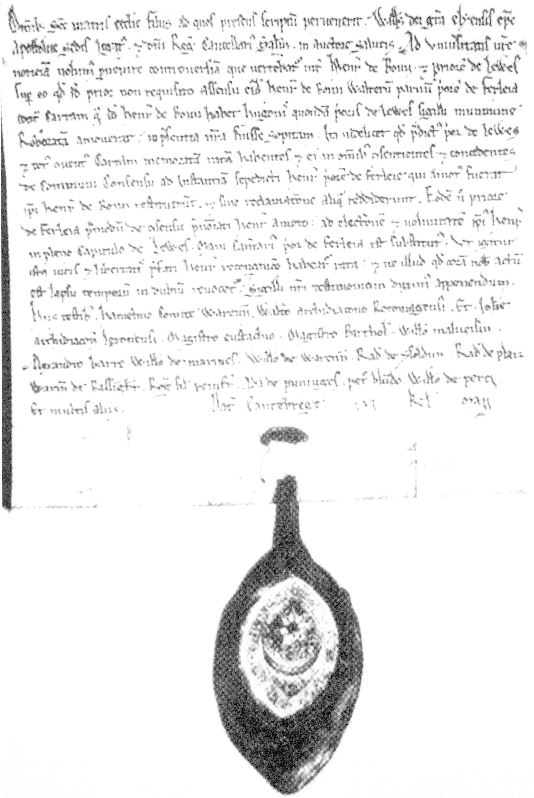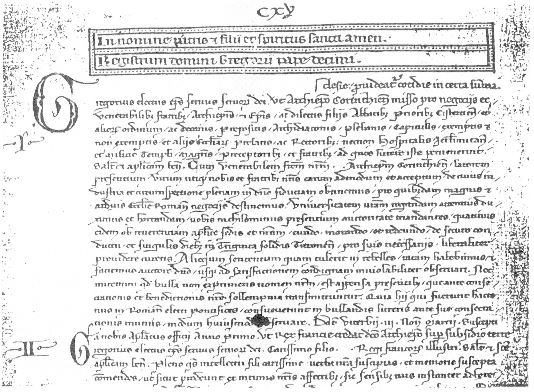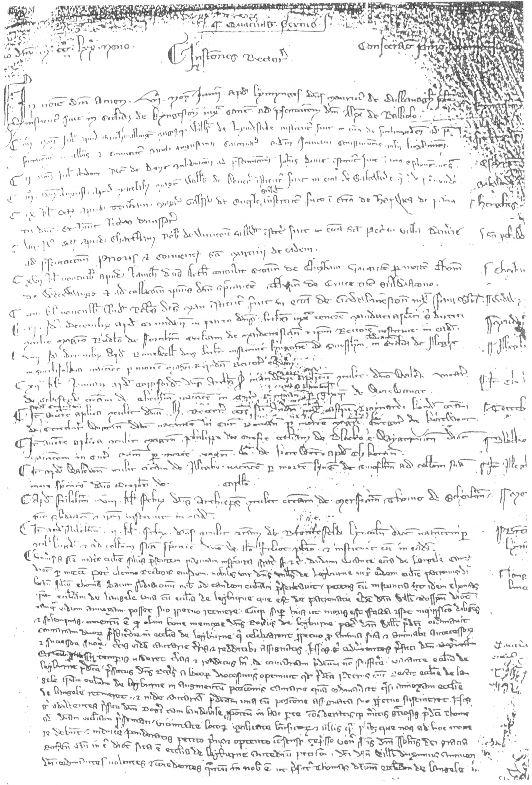[p. 161] The Influence of Papal Documents on English Documents before 1305
Historians, art historians and diplomatists have long flirted with influences. Changes, however, depend on many and variable factors and often the influence cannot be established with certainty. If made, they may not be lasting. I approach the subject then with some trepidation and caution. I propose to discuss the question under six main headings (1) the influence of papal privileges and mandates on English episcopal documents (2) the effects of the judge delegate system (3) the despatch of legates (4) the introduction of notaries (5) the possible influence on royal documents. Finally (6) I shall look at parallel developments.
1. The influence of papal privileges and mandates on English episcopal documents
The growth of the canon law and increasing personal contacts between the English hierarchy and the Roman curia are the motive forces behind the first influences. Documents which were recognizably modelled on papal documents begin to be issued by the English bishops in the 1140s (plates 1A, 1B (both 1143), 1C (1149), 1D (1151–2)). Earlier episcopal documents were modelled on royal charters and writs (e.g. plate 2A (1112 × 14)),1 demonstrably Ranulf Flambard’s charters.2 This royal influence continued – for example, at Norwich, in a charter of William Turbe of c. 1150 we find Notum … volo et precipio … (plate 2C). Indeed, with some bishops and in some dioceses, it survived to the end of the twelfth century. As late as 1195 × 1205 the writ type continued to be used at Bath and Wells (plate 2B). But, among more centralizing churchmen who had visited Rome, and with a growing number of papal privileges and [p. 162] mandates coming into the dioceses, papal influences began to make themselves felt.
Influences through papal documents on individual archbishops and bishops can be readily illustrated. The English Episcopal Acta project, for which volumes for eight of the sixteen dioceses (Canterbury, York, Bath and Wells, Exeter, Hereford, Lincoln, Norwich, and Winchester) have now appeared – not all are complete – enable us to examine the process of infiltration in more detail. A picture is emerging of very considerable variation in the dates of adoption of various papal styles, of differences between dioceses, of advances and of regressions.
To take the arenga as an example. In contrast with the continent the English examples of arenge are rare. In some dioceses it was never employed; in some it appeared unusually early, in others late. Not surprisingly, an arenga is usual in the documents of Archbishop Theobald of Canterbury (1138–61), who maintained close contact with the pope, but its use declines at Canterbury between 1161 and 1193, the accession of Hubert Walter. William Warelwast, bishop of Exeter (1107–37), who had undertaken at least eight missions to the papal court and who continued to act for the king at the curia between 1114 and 1120 in the Canterbury and York dispute, introduced it in his documents.3 He also used servus servorum Dei in a foundation charter for Launceston priory.4 At Lincoln, it was increasingly used under Bishop Robert Chesney (1148–66), for whom there are seventy-three examples: there are only fourteen for Bishop Alexander the Magnificent (1123–48).5 At Bath and Wells it occurs in two documents for Monkton Farleigh of 1123 × 35 and 1136 × 1166.6 It is possible that petitioners seeking re-confirmations were responsible for its survival and continued use in some instances, of which this may be one. The arenga is exceptional at Hereford, while at Winchester its use by Bishop Peter des Roches in 1205–38 has been described as archaic.7 Immediately one sees the volatile qualities of influence.
Another interesting borrowing is shown by Dr Julia Barrow.8 Bishop Robert Foliot of Hereford models an arenga in a document of 1177 on one [p. 163] of Archbishop Richard of Canterbury of 1174 × 5,9 and there is a close relationship between this arenga of Richard and another of his in a charter in favour of the church of Hereford.10 Both were witnessed by Peter of Blois who may have composed the Canterbury arenga. Reginald, the Hereford clerk who drafted Foliot’s document, probably accompanied his bishop to Westminster in 1177 and it may have been there that he came across a formulary.
What is indisputable is that papal privileges and papal mandates were influential, but at no time and in no place did the imitations come to look like the fully blown episcopal privileges of Metz, Salzburg, Sens and Rheims.11 It would be tedious to rehearse the evidence diocese by diocese and episcopate by episcopate, and in any case the excellent survey of Professor Hageneder on the diplomatic of bishops’ documents before 1259, read to our 8th International Congress, makes this unnecessary.12 The following is, therefore, a brief résumé. Features of the hand-writing, enlarged minuscules, tittles and ligatures were copied (3A and 3B), as were the cross and the invocation (4A and 4B). In a few instances subscriptions are found, for instance, to an award made on 6 November 1200 by Bishop Eustace of Ely, Abbot Samson of Bury St Edmunds, and Roger dean of Lincoln, acting as arbiters in the suit between the archbishop of Canterbury and the prior and convent of Christ Church, Canterbury, over building a college at Lambeth, where Archbishop Hubert and Prior Geoffrey subscribed their names Ego .h., Ego .G., preceded by holograph crosses. Their scribes completed the sentence of acceptance of the arbitration, in which both dignitaries declared that they had accepted (recepi) the arbitration, had subscribed, and had confirmed it by the attachment of their seals, Prior Geoffrey declaring that he had acted on behalf of the convent. Presumably the importance and the solemnity of the document demanded subscriptions in this case (plate 5).13 Another example is provided by an agreement made in [p. 164] 1185, on the intervention of King Henry II, where the Knights Hospitallers of Jerusalem surrendered to Richard of Ilchester, bishop of Winchester, the custody of the hospital of St Cross outside the walls of Winchester. The document was subscribed by the bishop, by the warden (custos) of the Knights Hospitallers, by the prior of the Order in England, and by three of the brothers.14 In some episcopal chanceries the cursus was employed: at Hereford by Gilbert,15 at Lincoln, sometimes, by Hugh.
The incipit was taken from papal documents, sometimes with no variation Iustis petentium desideriis and Quoniam ut ait, sometimes with a little adjustment, Iustitie ac rationis and Religiosis desideriis assensum used by Bishop Robert Chesney in 1148 × 60.16 In confirmations of a general kind, the phrases concerning the liberality of kings, princes and the Christian faithful, so familiar in papal documents of a similar nature, make their appearance in documents of Bishop Robert Bloet of Lincoln, c. 1107 × 23, of Bishop Henry of Blois of Winchester, 1139 × 1143, and of Bishop Alexander of Lincoln, c. 1143 × 7.17 The phrase ‚what is possessed justly now and reasonably in future‘ (alia omnia que iuste et canonice in presentiarum possident et que futuris temporibus rationabiliter adquirere poterunt) is also taken over: it is found at Lincoln in 1107 × 23, 1150 × 66, and 1154 × 66.18
Salutations sometimes include the benedictionem.19 Salutem et dei benedictionem occurs in two episcopal confirmations for Oseney of some twenty years apart, 1143 × 7 and 1163 × 6, one obviously copying the other.20 Archbishop Richard of Canterbury, threatening King Henry II with excommunication used spiritum consilii cum salute, composed by Peter of Blois, foreshadowing the formula employed by Pope Innocent III of spiritum consilii sanioris.21 Influences might come through letter collections, [p. 165] letter-books and formularies: their effects, of course, were not all in one direction.
The dispositio, Eapropter …, can be found, quite commonly, following the papal form (plate 6A).
The sanctions were modelled on those of the papal chancery from the 1120s. For Richard I (Belmeis) of London we find reddo inquam et anathematis gladio … Si quis autem … in charters of c. 1127 and 1108 × 27.22 With Archbishop Theobald the salva clause appeared, ‚saving the canonical obedience of the diocesan bishop‘, (salva diocesani episcopi canonica obediencia).23 Archbishop Richard of Canterbury, confirming documents of Theobald, used Nulli ergo omnino … Pax dei and Si qua igitur, Cunctis autem.24 At Winchester, Henry of Blois employed Quod si quis iniuste attemptaverit dei indignationem nisi resipuerit se noverit incursurum in a document datable to 1153 × 67.25 At Lincoln we find Si quis vero id attemptare presumserit indignationem … Cunctis…, and at Hereford, in a charter of 1139 × 40, Si quis ergo – not followed by a blessing – and in another of probably 1202, … vel ei ausu temerario contraire. Si quis vero hoc attemptare presumpserit indignationem dei … se noverit incursurum.26
Examples of the use of the apprecatio show some variation. It is found at Lincoln in the 1140s under Bishop Alexander in a charter of his of 1143 × 7, with anathema (1B), and a single apprecatio is employed under Bishop Robert Chesney in 1149 (1C).27 At Norwich it occurs several times, on one occasion with the variation Fiat, fiat, fiat for William Turbe (1146 × 74), and at Bath and Wells.28 At Canterbury, it is scarce, and there is no example of a triple apprecatio.29
One cannot put too fine a point on the inclusion or omission of these features because often we are at the mercy not only of time and decay, but also of copyists for whom the diplomatic niceties were not important. A charter of Bishop Richard (Fitzneal) of London of 1191 included the Bene valete but when it was copied into the St Paul’s register it was omitted.30 [p. 166] Bene valete was employed by Hugh of Avalon at Lincoln in 1186 × 94 and in 1189 × 93, the latter a judge delegate document from a cartulary.31
Papal influence is also to be found on archiepiscopal and episcopal mandates. The incipit Conquestus est nobis is used by Bishop Henry of Blois of Winchester (1140 × 31 Dec 1143).32 A mandate of 1151 × 1161 of Archbishop Theobald has all the features (plate 6A): … salutem. Questi sunt nobis … Eapropter … precipimus quatinus … Si autem restituere noluerint eosdem a liminibus sancte ecclesie arceatis. Valete. Easier to survey, because of a better survival, are the administrative acta of Archbishop Hubert Walter which re-create the phrases of the papal mandate to judges delegate with consummate ease: significante nobis, convocatis partibus … fine debito decidatis.33 The clauses concerning the witnesses, Testes autem,34 and the service of the judges, Quod si non omnes, follow exactly the papal pattern.35
2. The effects of the judge delegate system36
The introduction and growth of the judge delegate system had brought many ecclesiastics into contact with papal mandates. They thus absorbed papal phraseology, the phraseology of the adapted Roman civil law procedure. Specific mandates of instruction were used at first and in difficult cases. Soon formularies, containing examples of the documents issued at each stage of the suit, and ordines iudiciarii, procedural treatises, circulated amongst the judges. Many ecclesiastics – and by the thirteenth century this meant not only bishops but also abbots and priors, sometimes of quite insignificant houses – became acquainted with what came to be called the Romano-canonical procedure. The term instrumenta publica is found in a letter of English judges delegate of 1173; this is a case of direct absorption of a Roman term.37 The intermediary acta of the judges thus conformed to the terminology of a common system which would have been recognizable at the curia. If the judges sub-delegated or ordered officers to make citations, their letters and mandates were, too, in terminology at least [p. 167] close to papal models. Another legacy of the system was the recitation of the full document. This feature of the judge delegate charter had an influence on the inspeximus. Important, too, is the move towards dating judicial acta which had some influence on the dating of episcopal awards in the 1160s and 1170s under Bishop Bartholomew.38 His successor, John the Chanter (1186–1191), was loath to date, perhaps, suggests Professor Barlow, because he was never a judge delegate.39
But the final acta were frequently in the native chirograph form in England40 (plate 7A), and were never notarial.41 Through the judge delegate system many Roman law concepts about judicial documents and the judicial process entered the ecclesiastical courts but they did not immediately get much further (7B). Striking examples of the influence of the language of judges delegate are provided in the documents issued by the prior and chapter of Canterbury exercising jurisdiction in the early 1240s, when the archbishopric was vacant (8A and 8C). On the other hand, the look of the charters themselves is very ‚English‘, and one (8B), issued by the abbot of Combe, is undated. The subject of monastic chanceries badly needs investigation. From a brief search my suspicion is that in most instances unconnected with judges delegate the use of papal models was rare.
3. The despatch of legates
Documentary influence might be expected to have come from the papal curia via the legates. ‚Papal‘ incipits and phrases are common among legatine documents throughout Europe, Iustis petentium desideriis, for example, used by Guala and Konrad of Urach.42 However, what a legatine [p. 168] document might look like depended very much on whether the draftsmen and scribes were English or Italian, and on the particular circumstances of the issue and on the type of document required. Mandates of legates looked like papal mandates and legatine confirmations and privileges were likely to follow papal forms. Original legatine charters are scarce before the thirteenth century. As far as one can say, given the limitations of present research, influence from this source appears to be non-existent.
John of Salerno’s document for the abbot and convent of Westminster of 1201 is entirely modelled on a papal indult but the hand does not look like a papal one (plate 9A).43 It is difficult to see much papal influence in the document of Nicholas bishop of Tusculum of 20 June 1214 (10B), settling a dispute. On the other hand, an indulgence for those visiting and contributing to a priory, has distinctly papal echoes in the rogamus, monemus et hortamus and in the final clause of relaxation (10A).
A document of the legate Guala (1216–18) appears to be in an English hand (plate 9B).44 The dating clause reflects the style of the papal chancery. An original of the legate, which was printed by H. G. Richardson, shows him using the same title and greeting and dating style.45 As a mandate, it reproduces the language of the papal mandate Quocirca vobis … mandamus quatinus ….
There is some evidence that the legates brought trained scribes with them. Pandulf (1218–21) enjoyed the services apparently of the erstwhile papal scribe, master Iacobus, although I know of no document written by him, and English scribes undoubtedly wrote many of his letters.46 An exception may be plate 11C, which, if not in a ‚papal‘ hand, absorbs the style and form very convincingly. Pandulf was also bishop-elect and then bishop of Norwich so we have here an interesting amalgam of roles. Two ‚hybrid‘ letters, one issued as bishop-elect and legate (from London), the other as bishop (from Rieti), illustrate their confused ancestry. The address and the witnessing clause of both are undoubtedly ‚English‘ but some of the letter forms and the dating clause show papal influence (plate 11A and 11B). Although Italian clerks came to England with the legate Otto (1237–41), [p. 169] English scribes continued to be used by the legate. English scribes found employment, too, under the legate Ottobuono (1265–8), although he had an Italian chancellor, master Ardicio de Comite. There is an original mandate of the legate which is cast totally according to the forms and style of the papal chancery, although the hand is English, and the scribe gives his name following the style of the papal Chancery on the right plica, H. de Cicest’ (H. of Chichester).47 Ottobuono’s original legatine charters have not so far been investigated, but letters that were used for a formula have been published,48 and two of his letters, again not originals, but including the legate’s title, names of the addressee(s), greeting and dating clause, which may fairly be compared with Westminster Abbey Muniments 12376, show considerable papal influence.49
4. The introduction of notaries50
No examples of notarial documents are known for the legate, Otto,51 and until the 1250s notaries were unknown in any circles in England. This in part explains the very superficial and piecemeal borrowing in the English episcopal chanceries. By the mid-thirteenth century, however, notaries began to be employed by the royal court, often for marriage arrangements with foreign royal houses. Notaries also came in the company of Italian bankers and papal tax-gatherers in the 1260s and were used on business concerning benefices and papal taxes in the late 1270s. It is possible that Ottobuono had some influence in the introduction of notaries. Notaries were employed in his courts and a notary used in 1266 was probably an Englishman. After 1279 notaries began to appear in episcopal chanceries and to be native born. This was, in part at least, due to the influence of the Italian notary, John of Bologna, who accompanied Archbishop John Pecham – resident for some while at the curia – to England, on his appointment to the see of Canterbury in 1279. The notion that documentary practices should be standardized and uniform was expressed in John of Bologna’s Summa which opens with the words ‚As the Roman [p. 170] Church is the mother and mistress of all churches, so each church should copy its usages‘.52 Precision was required in legal documents (as outlined in the Summa) and particularly in matters concerning benefices.53 Englishmen, who had been at Rome on business as petitioners or proctors, readily recognized the desirability of copying curial practices and notarial models, if they were to succeed in their business and suits, whether it concerned benefices and provisions or letters of proxy, bonds and receipts.
Archbishop Pecham had faculties from the pope to create three notaries public in 1279 and another two in 1292. Some English notaries, such as Johannes Alani de Beccles, had been engaged on business at the curia before Pecham’s appointment and no doubt helped now to bring about a change to greater uniformity in ecclesiastical circles. It was thus some measure of personal influence through the archbishop and his notary, coming at a time when there was a willingness and desire to produce the most effective documents, that encouraged ecclesiastics, the episcopal hierarchy and the greater religious houses, to employ notaries.
5. The possible influence on royal documents
The diploma, which in any case fell rather short of the elaborate continental model, with its rota, beehive etc., had largely died out by the early twelfth century. It lasted slightly longer where ecclesiastical matters were concerned. Two late examples are the foundation charter of King Henry I for the see of Ely of 1109,54 and a charter, again in diploma form, of King Stephen of 1136 (Apr.–21 Nov.) for Exeter (plate 12A). Monastic foundation charters were likely to be based on the model of a papal privilege, but here the influence was probably much stronger when the house had foreign connections, as did the Cluniac house of Lewes, for which there survives a diploma of William de Warenne of c. 1078–82 (plate 12B). Features of papal documents began to be re-created in English royal charters usually when ecclesiastics were the recipients, in particular where they were Norman and probably where the scribes were supplied by the petitioners. Under King Henry II we find examples of enlarged minuscules (plate 13A), tittles, and what are very close to ligatures (plates 13B and 13C) in [p. 171] royal charters. Until the majority of royal charters were written by royal scribes, however, there was much variation in practice. The papal influences are undeniably there, but they are few and exceptional, and usually superficial.
It was not until the reign of Henry II’s son, Richard I, that something approaching the diploma re-appeared. It was now distinctly comparable with the papal privilege in some of its external features, especially in the Dat. per manum clause. This particular dating clause was used by Richard I before his coronation and its adoption has been associated with William Longchamps, Richard I’s chancellor when he was count of Poitou. Longchamps was royal chancellor and bishop of Ely from 1189, and later to be legate in 1190–91 (plate 14A and B).55 From the royal chancery, the Dat. per manum dating clause spread to episcopal chanceries.
(The per manum clause with the place date was used by a scribe of Henry II, Stephen of Fougerès, Testibus … per manum Stephani capellani apud Wdestoc’. This was seen by Galbraith56 as an individual quirk, and a possible reaction to the strictures of a conservative chancery which was not to be influenced by a prevailing fashion.)
Longchamps’ charters, which he issued as chancellor, bishop, and legate, need serious and detailed attention which this paper cannot give. Two documents of his (plates 15A and B) must suffice to show the various influences. The first with its precipimus vobis quod … is like a royal writ: it terminates with the clause Teste me ipso and is sealed on a tongue: the second is like a solemn episcopal charter, recording a settlement, with its general address Omnibus sancte matris ecclesie filiis and the greeting salutem in auctore salutis. It ends with the date, Dat. Cantebrege xi kal. Maii.
By the thirteenth century, although some of the influences were still pretty cosmetic, for example, tall ascenders in the first line of charters of Henry III,57 there was much closer and more meaningful contact and exchange between the papal and the English royal chancery. Henry III had proctors, some English, some Italian, who carried out his business at the curia, men familiar with the practices of both courts. We have already referred to the papal nuncios, tax-gatherers, clerks of the Chamber and the legates, coming into England with increasing frequency. Common areas of [p. 172] business, especially concerning benefices, account for the adoption of phrases in royal documents. The non obstante clause is first found employed under John in 1205 and then again in 1206. Both instances concern ecclesiastical benefices – the grant of a rent to Peter des Roches, notwithstanding any mandate or other letters to the contrary, and the presentation of a royal clerk, Master Henry of Hereford, notwithstanding the presentation of another clerk.58 Geoffrey Barraclough, in an important article in 1954, showed that phrases which permeated benefice business in the mid-thirteenth century were taken from the papal chancery.59 These were the phrases which the clerks read in papal letters and came to introduce into the English royal chancery. Now, indeed, they come to use the papal terms ‚mandate‘, ‚mandate of provision‘ and ‚grace‘ for the English ‚writ‘, letters and ‚letters patent‘. Barraclough concluded that ‚it seems certain that provisions were the door through which, more generally, the forms and style of the papal chancery made their way into England‘. More correctly it might be said that these forms and terminology affected the royal chancery much as the forms of papal mandates to judges delegate had influenced the bishops’ chanceries fifty years previously. Indeed, the quod si non omnes clause, found also in benefice documents, was one familiar to all papal judges delegate.
6. Finally I come to what I have called parallel developments
The similarity between the English writ and the papal mandate has already received some comment.60 The writ was at the heart of English administration, as essential to royal government and the common law as indeed was the papal mandate to the judge-delegate system. All chanceries had their mandata, but in none did they assume such importance as in the English royal chancery. This is because the writ form brought about the development of the writ-charter, while at the same time maintaining its original purpose as a mandate and becoming a keystone – in the shape of the judicial writ – of the developing Common law. It is thus distinctly comparable to the papal judicial mandate, but there is no evidence that one [p. 173] affected the other. They were rather parallel developments with no real signs of reciprocity.
The same may be said of registration. While scribes would have been familiar with original papal privileges, mandates, letters of grace and of justice, they would not have seen the registers and rolls of other administrations. Registration commences in the English royal chancery in 1199, although financial records had been enrolled in the Exchequer from at least 1131 – and the Cartae Antiquae rolls of the Exchequer exist from the reign of King Richard I. Various scholars have endeavoured to trace English chancery registration to papal influences and to connect the equally momentous beginnings of registration in episcopal chanceries to the Fourth Lateran Council. A detailed comparison between thirteenth century papal registers and thirteenth century English royal rolls shows no direct borrowing in the method. The royal charter rolls commence in 1199, patent rolls in 1200, and close rolls in 1203. The distinction between patent and close rolls is according to the sealing – whether the letter was sent open or sealed to close, being dependent on its purpose. It is a different and earlier distinction than that between common and curial letters in the papal registers. It is also apparent that the enrolment on the close and the patent rolls (as opposed to the charter rolls) does not proceed from the actions of the recipients. The charter rolls, on the other hand, do, and like the papal registers, consist of full transcripts (plate 16A), while the patent (plate 16B) and close rolls are entirely in shortened form.
Bishops registers, which start in England with the rolls of the bishop of Lincoln (Hugh of Wells, 1209–35), are more easily compared, as administrative records, with the royal records than with the papal registers (for an example of a papal register, Gregory X’s, see plate 17A). For Hugh of Wells there were originally from 1214 two classes of registration record (1) charter rolls and (2) rolls of institutions. The charter rolls consist of outgoing letters, in full except for familiar and set phrases and thus similar to royal charter rolls, and to papal registers to some degree, while the institution rolls are summaries of administrative acts, quite unlike anything to be found in the papal registers and with only slight similarities with the close rolls.61 Both the bishop of Lincoln, Hugh of Wells, and the archbishop of York, Walter de Gray, for whom there are also early rolls, had been in the royal chancery under Archbishop Hubert Walter of Canterbury and the innovation of registration, it has been argued, is likely to be due to that experience. [p. 174] Hugh of Wells’ rolls pre-date the Fourth Lateran Council and so influence from that source is impossible. But perhaps no such steps to administrative improvement would have been made without the interdict imposed by the pope on England from 1208–1213 which resulted in a complete breakdown in the administration of the dioceses. No register survives for the premier province and diocese until Archbishop Pecham in 1279 (plate 17B). It is close in style to other contemporary episcopal registers, is in book form, and shows no signs of notarial influence, although the archbishop’s registrar, Johannes Alani de Beccles, was a notary in the court of Canterbury in 1271, and, as has been pointed out, the archbishop brought John of Bologna with him to England.62
Canterbury rolls or registers may have existed from earlier. We simply do not know. The problem highlights again the difficulties of arguing from inadequate evidence in such a fluid and elusive subject as influence.
To sum up: need and usefulness always conditioned the drafting and effectiveness of documents. The documents that were produced came out of the needs of the administration, the phraseology being at the heart of the act. The real influences are to be seen in the legal/business spheres in the phraseology which was introduced through the judge delegate system from the late twelfth century onwards and through the benefice business of the mid to late thirteenth century. Channels of contact between governments and administrations opened up clearly in these areas. Though the other influences may seem of a more superficial kind and were to some extent antiquarian, they were ‚the outward and visible sign‘ of the purpose of the document, re-enforcing authority and giving some sense of uniformity to the type of document. Native traditions survived and some influences were probably very transitory, yet there was a common European experience in which the Papal chancery played a key part.63
References to the Plates
- 1.
- A Salter (as n. 19) no. 69
- B Salter (as n. 19) no. 70
- C Salter (as n. 19) no. 63
- D BL (as n. 14) 28 pl. xviii
- [p. 175] 2.
- A English Episcopal Acta V (York 1070-1154), ed. J. E. Burton, Oxford 1988, pl. 1 no. 19
- B Bath and Wells (as n. 6) pl. iv no. 255
- C Norwich (as n. 28) pl. ii no. 79
- 3.
- A Exeter (as n. 3) pl. vi no. 219
- B Canterbury (as n. 9) pl. vii
- 4.
- A Norwich (as n. 28) pl. i no. 43
- B Salter (as n. 19) no. 5
- 5.
- Cheney (as n. 13) pl. vi
- 6.
- A Salter (as n. 19) no. 72
- B Canterbury, D(ean) and C(hapter), Christ Church Letters ii no. 231
- 7.
- A Winchester (as n. 1) pl. iii no. 204
- B Canterbury, D. and C., Chartae Antiquae H 120
- 8.
- A Canterbury, D. and C., S(ede) V(acante) (Scrap)b(oo)k II 204
- B Canterbury, D. and C., Christ Church Letters ii no. 230
- C Canterbury, D. and C., S V bk II 201
- 9.
- A W(estminster) A(bbey) M(uniments) 12733 (John of Salerno)
- B WAM 51111 (Guala)
- 10.
- A WAM 3779
- B Bodleian Library, Oxford University Archives WP/P/xii/1 (Nicholas of Tusculum)
- 11.
- A P(ublic) R(ecord) O(ffice) E40/14104 (Pandulf)
- B PRO E 327/533
- C Cumbria Record Office, Carlisle, D/MH/4
- 12.
- A Regesta Regum Anglo-Normannorum iv 1066–1154, ed. H. A. Cronne and R. H. C. Davis, Oxford 1969, pl. xlii
- B Early Yorkshire Charters, ed. C. T. Clay, viii pl. 1 no. 2
- 13.
- A Salter (as n. 19) no. 29
- B BL (as n. 14) 54 pl. xxxv
- C T. A. M. Bishop, Scriptores Regis, Oxford 1961, pl. xxxi (b)
- 14.
- A BL (as n. 14) 70 pl. xlv
- B Bishop (as n. 13 C) pl. xxxvii (b)
- 15.
- A Guildhall Library, London, St Paul’s MS 25, 122/770; printed: Early charters (as n. 22) no. 75 p. 54
- B PRO DL 27/3
- 16.
- A Charter Roll 18 Edward I m. 2 (Oct. 1290)
- B Patent Roll 4 John m. 7 (Nov.–Dec. 1202)
- 17.
- A Register of Pope Gregory X, Archivio Segreto Vaticano, Reg. Vat. 37, fol. 115
- B Register of Archbishop Pecham, Lambeth Palace Library, fol. 48
